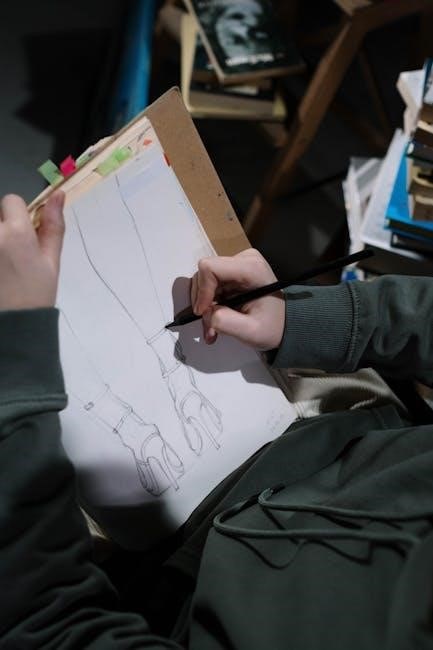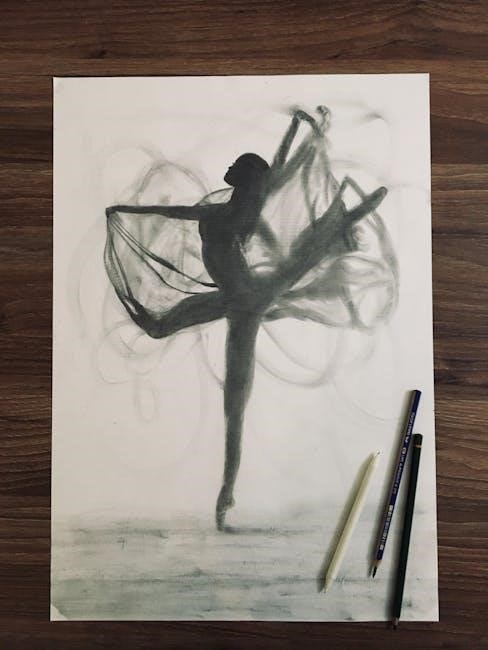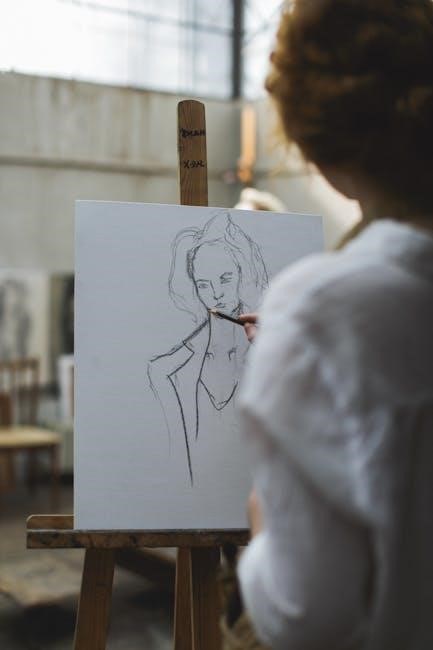
figure drawing for all it’s worth pdf
Figure drawing is a foundational art form that captures the human figure’s essence‚ blending anatomy‚ structure‚ and emotion. It demands practice‚ observation‚ and dedication to master its mechanics and expression‚ transforming simple sketches into profound artistic statements.
The Importance of Practice in Figure Drawing
Consistent practice is essential for mastering figure drawing‚ as it refines skills and deepens understanding of anatomy‚ structure‚ and expression. Regular sketching helps artists develop keen observation and capture the subtleties of the human form. Through repeated exercises‚ such as gesture drawing and quick sketches‚ artists build confidence and precision. Practice also fosters creativity‚ allowing individuals to experiment with tools and techniques‚ from HB pencils to wax crayons. As emphasized in resources like Figure Drawing: Design and Invention‚ practice transforms mechanical drawing into expressive art‚ enabling artists to convey emotion and movement effectively. Dedication to practice is the cornerstone of growth in figure drawing.
Understanding the Basics of Figure Drawing
Mastering the fundamentals of figure drawing involves grasping essential principles such as proportion‚ perspective‚ and anatomy. Artists learn to simplify the human form into basic shapes and structures‚ enabling accurate depictions. Surface anatomy and the relationship between bones and muscles are key to capturing poses and movements. The nude form serves as a foundational study‚ revealing the underlying mechanics of the body. By understanding these basics‚ artists can construct figures from imagination or observation‚ as discussed in resources like Figure Drawing: Design and Invention. This foundation allows for creative expression and technical precision‚ forming the building blocks of successful figure drawing.
The Approach to Figure Drawing: Mechanics and Expression
Figure drawing balances technical mechanics and creative expression‚ requiring artists to understand both the structure of the human body and the emotional essence of their subject. The process involves observing and rendering the figure’s proportions‚ anatomy‚ and movement while capturing its dynamic energy. Gesture drawing is a key method‚ focusing on quick sketches to convey posture‚ motion‚ and attitude. This approach emphasizes simplifying the figure into basic forms and lines‚ allowing for both accuracy and artistic interpretation. Resources like Figure Drawing: Design and Invention and Andrew Loomis’s teachings provide guidance on mastering these principles‚ blending technical precision with expressive creativity to bring the figure to life on paper.
Gestures and Movements in Figure Drawing
Gestures and movements are vital in figure drawing‚ capturing the essence and energy of the human form through quick sketches and dynamic poses‚ emphasizing life and fluidity.
Gesture Drawing: Capturing the Essence of the Figure
Gesture drawing focuses on swiftly capturing the figure’s pose and energy‚ often in short time frames. This technique emphasizes the model’s movement and vitality‚ prioritizing expression over precise details. By using quick sketches‚ artists can distill the essence of the figure‚ translating its dynamic presence onto paper. Tools like HB pencils‚ pens‚ and wax crayons are commonly employed to explore different textures and lines; Gesture drawing trains the artist’s eye to observe the figure’s rhythm and flow‚ fostering spontaneity and confidence. Regular practice with this method enhances the ability to render the human form with accuracy and emotional depth‚ essential for all figure drawing endeavors.
Quick Sketch Techniques for Gesture Drawing
Quick sketch techniques in gesture drawing involve capturing the figure’s movement and energy within short time frames‚ often 10 to 15 seconds. This method emphasizes simplicity and immediacy‚ focusing on the figure’s essential lines and poses. By prioritizing the figure’s rhythm and flow‚ artists can distill its dynamic presence into concise‚ expressive sketches. These rapid exercises train the hand and eye to work in unison‚ fostering spontaneity and confidence. Regular practice with quick sketches enhances the ability to render the human form with accuracy and emotional depth‚ making it an indispensable tool for mastering gesture drawing and figure drawing as a whole.
Using Different Tools for Gesture Drawing (HB Pencil‚ Pen‚ Wax Crayon)
Various tools like HB pencils‚ pens‚ and wax crayons offer unique textures for gesture drawing. HB pencils provide moderate contrast‚ allowing precise yet expressive lines. Pens create bold‚ fluid strokes‚ emphasizing gesture’s dynamic qualities. Wax crayons produce rich‚ vibrant marks‚ adding emotional intensity. Each tool encourages experimentation‚ helping artists explore different aspects of movement and form. By alternating between these mediums‚ one can enhance their ability to capture the figure’s essence effectively. This diversity in tools enriches the drawing process‚ fostering creativity and versatility in gesture drawing techniques.

Anatomy and Structure in Figure Drawing
Anatomy and structure form the foundation of figure drawing‚ enabling accurate depictions of the human form. Understanding surface anatomy simplifies the mechanics of the figure‚ fostering dynamic‚ lifelike art.
Surface Anatomy: Simplifying the Mechanics of the Figure
Surface anatomy focuses on the visible structures of the body‚ such as muscles‚ bones‚ and landmarks‚ to simplify the drawing process. By understanding these elements‚ artists can break down the figure into basic forms and movements‚ making it easier to capture proportions and dynamics. This approach emphasizes the relationship between structure and function‚ allowing for more accurate and expressive representations of the human form. It also helps in creating the illusion of depth and dimension by highlighting key anatomical features. Surface anatomy is a crucial tool for both beginners and experienced artists‚ enabling them to draw the figure with confidence and precision‚ whether from life or imagination.
Understanding Bones and Muscles for Accurate Figure Drawing
Accurate figure drawing relies heavily on a solid grasp of the skeletal and muscular systems. Bones provide the structural framework‚ while muscles determine movement and form. By studying their relationships‚ artists can better capture the figure’s proportions‚ posture‚ and dynamics. For instance‚ the pelvis and femur dictate hip alignment‚ while muscles like the deltoids and quadriceps shape the arms and legs. Sketching skeletons and observing how muscles interact with bones helps refine anatomical accuracy. This knowledge also aids in depicting realistic movements and tension‚ ensuring drawings reflect the figure’s underlying mechanics. Mastery of bones and muscles is essential for creating lifelike‚ dynamic‚ and anatomically correct figure drawings‚ whether from observation or imagination.
The Role of the Nude in Figure Drawing
The nude form has long been a cornerstone of figure drawing‚ offering unparalleled insight into human anatomy and structure. Studying the nude allows artists to observe and render the natural proportions‚ contours‚ and movements of the body without the distraction of clothing. This direct observation enhances the ability to accurately capture the relationships between bones‚ muscles‚ and skin. The nude also serves as a basis for understanding the mechanics of the figure‚ enabling artists to depict both static poses and dynamic movements with precision. By mastering the nude‚ artists gain a deeper understanding of the human form‚ which is essential for creating lifelike and expressive figure drawings‚ whether from life or imagination.
Perspective and Proportion in Figure Drawing
Perspective and proportion are essential for creating accurate and visually appealing figure drawings. They allow artists to depict the human form with depth‚ balance‚ and realism‚ enhancing the overall composition and representation of the figure.
Linear Perspective in Figure Drawing
Linear perspective is a fundamental technique in figure drawing that creates the illusion of depth on a flat surface. By using converging lines that meet at a vanishing point‚ artists can accurately depict the three-dimensional structure of the human form. This method is especially useful for drawing figures in dynamic poses or complex environments. Properly applied‚ linear perspective ensures that the proportions of the figure remain consistent and believable. It also enhances the sense of scale and distance‚ making the drawing more immersive. Artists often combine linear perspective with anatomical knowledge to achieve realistic and compelling results‚ as emphasized in resources like Andrew Loomis’ Figure Drawing For All Its Worth and Michael Hampton’s Figure Drawing: Design and Invention. These tools and techniques help bridge the gap between technical accuracy and artistic expression‚ allowing for a more engaging representation of the human figure.
Proportion and Measurement Techniques
Accurate proportion and measurement are critical in figure drawing to ensure the human form is depicted realistically and harmoniously. Artists often use a reference point‚ such as the length of the head‚ to measure other body parts proportionally. Techniques like dividing the body into segments or using a grid system help maintain balance and consistency. Tools like calipers can aid in transferring measurements from a model to paper. Proper proportion ensures that the figure appears natural and balanced‚ while incorrect measurements can lead to distortions. By mastering these techniques‚ artists can achieve a cohesive and believable representation of the human form‚ as detailed in resources like Figure Drawing For All Its Worth and Figure Drawing: Design and Invention.

Materials and Tools for Figure Drawing
Essential tools for figure drawing include HB pencils‚ pens‚ and wax crayons. Use high-quality paper or canvas‚ supported by easels and sketchbooks. Erasers and sharpeners are indispensable for precision and maintenance.
Essential Tools for Figure Drawing
Figure drawing requires a thoughtful selection of tools to achieve desired results. HB pencils are ideal for detailed work‚ while pens offer bold‚ expressive lines. Wax crayons add texture and vibrancy. Erasers and sharpeners are crucial for refining sketches. High-quality paper or canvas ensures durability‚ and sketchbooks are perfect for practice. Easels provide comfort for extended drawing sessions. Blending stumps and tortillons help soften tones‚ while kneaded erasers allow precise corrections. A variety of tools enables artists to explore different techniques‚ from delicate shading to dynamic gestures. Investing in the right materials enhances creativity and precision‚ making the drawing process more enjoyable and effective for artists of all skill levels;
Experimenting with Different Drawing Mediums
Exploring various drawing mediums enhances creativity and adds depth to figure drawing. Pencils offer precision and control‚ while pens create bold‚ expressive lines. Wax crayons provide vibrant textures‚ and charcoal enables dramatic shading. Ink encourages fluidity and experimentation‚ while pastels deliver soft‚ ethereal effects. Each medium offers unique challenges and opportunities‚ allowing artists to explore different styles and moods. Digital tools also open new possibilities for figure drawing‚ offering versatility and ease of editing. Experimenting with these mediums helps artists discover their preferences and expand their artistic range‚ making the creative process more engaging and versatile. This exploration is essential for developing a personal style and mastering the art of figure drawing effectively.

Light and Shadow in Figure Drawing
Light and shadow are crucial in figure drawing‚ creating depth‚ dimension‚ and emotion. Properly rendering shadows enhances the form and adds realism to the figure‚ making it dynamic.
Understanding Light and Its Impact on the Figure
Light is a fundamental element in figure drawing‚ as it defines form‚ texture‚ and depth. The way light interacts with the figure creates highlights‚ mid-tones‚ and shadows‚ shaping its three-dimensional appearance. Different light sources‚ such as direct or diffused light‚ influence the intensity and placement of shadows‚ adding complexity to the drawing. Shadows reveal the figure’s structure‚ while highlights emphasize its contours. By carefully observing and rendering light‚ artists can create a sense of volume‚ weight‚ and emotion in their work. Practice and study of light’s behavior are essential to master its impact on the figure‚ enhancing the overall composition and making the drawing more dynamic and engaging.
Rendering Shadows for Depth and Dimension
Shadows are crucial for creating depth and dimension in figure drawing‚ defining the three-dimensional form of the body. They reveal the figure’s contours‚ volume‚ and weight‚ while also adding context to the environment. Different shadow types‚ such as form shadows and cast shadows‚ play distinct roles. Form shadows occur on the figure itself‚ accentuating its structure‚ while cast shadows project onto surfaces‚ indicating placement and interaction with light. Techniques like hatching and stippling can enhance shadow rendering‚ adding texture and complexity. By carefully observing and drawing shadows‚ artists can achieve a more lifelike and engaging representation of the figure‚ capturing the interplay of light and dark that brings the subject to life.
Composition and Expression in Figure Drawing
Composition and expression are vital in figure drawing‚ as they convey emotion and movement. Artists use gesture and balance to create dynamic‚ harmonious pieces that reflect their artistic vision and storytelling.
Creating Dynamic Compositions
Dynamic compositions in figure drawing are achieved by balancing elements like line‚ shape‚ and value to capture energy and movement. Andrew Loomis emphasizes gesture drawing to convey action‚ while Michael Hampton suggests using basic shapes and forms to guide the eye. Proportion and measurement techniques help maintain harmony‚ ensuring the figure’s dramatic quality and emotion. By focusing on the spine and posture‚ artists can express the figure’s essence authentically. Experimenting with tools like HB pencils‚ pens‚ and wax crayons adds texture and depth‚ enhancing the visual impact. These methods inspire artists to create compelling‚ lifelike compositions that tell a story.
Capturing Expression and Emotion in Figure Drawing
Capturing expression and emotion in figure drawing involves conveying the model’s mood through posture‚ facial features‚ and body language. Andrew Loomis highlights the importance of gesture drawing to express the figure’s inner energy and movement. The spine’s curvature and limb positioning reveal emotional states‚ guiding the artist to interpret and translate feelings onto paper. Michael Hampton emphasizes simplicity‚ encouraging artists to focus on essential lines and forms to evoke emotion. Tools like HB pencils and pens can enhance expressiveness by varying line weights and textures. By studying anatomy and practicing observation‚ artists can master the subtleties of human emotion‚ creating impactful and relatable drawings.

Common Mistakes in Figure Drawing
Common mistakes include ignoring basic anatomy‚ incorrect proportions‚ and neglecting the overall pose. These errors often stem from poor observation and rushing the drawing process.
Identifying and Correcting Common Errors
Identifying errors in figure drawing involves recognizing discrepancies in anatomy‚ proportion‚ and pose accuracy. Common mistakes include misaligned joints‚ incorrect muscle placements‚ and disproportionate body segments. To correct these‚ artists should revisit basic anatomy‚ ensuring a solid understanding of bone and muscle structures. Proportions can be checked using measurement techniques and reference lines. Practicing gesture drawing helps capture the overall pose accurately. Regularly reviewing work and seeking feedback from instructors or peers can highlight overlooked errors. Correcting these mistakes requires patience and consistent practice‚ as mastering figure drawing is a gradual process that refines both technical skills and artistic expression over time.
Learning from Mistakes to Improve Your Craft
Mistakes in figure drawing are invaluable learning opportunities. Analyzing errors helps refine understanding of anatomy‚ proportion‚ and movement. By identifying inaccuracies‚ artists can address gaps in their knowledge and technique. Consistent practice and reviewing feedback are key to improvement. Embracing a growth mindset allows artists to view mistakes as stepping stones rather than setbacks. Over time‚ this iterative process enhances observational skills and artistic expression‚ leading to more accurate and dynamic figure drawings. Learning from mistakes fosters resilience and creativity‚ essential for mastering the complexities of figure drawing and achieving artistic growth.
Resources for Further Learning
Explore books like Figure Drawing: Design and Invention and Andrew Loomis’s Figure Drawing For All Its Worth for in-depth guidance. Utilize online tutorials and PDF resources for additional techniques and inspiration.
Recommended Books on Figure Drawing
For a deep dive into figure drawing‚ consider Figure Drawing: Design and Invention by Michael Hampton‚ which offers a fresh approach to constructing and imagining the human form.
Andrew Loomis’s Figure Drawing For All Its Worth remains a timeless classic‚ providing detailed insights into anatomy‚ structure‚ and expression for artists of all skill levels.
Another essential read is Burne Hogarth’s Dynamic Figure Drawing‚ known for its emphasis on movement and energy‚ perfect for capturing the vitality of the human figure.
These books are invaluable resources for mastering the fundamentals and advancing your figure drawing skills‚ blending practical techniques with artistic inspiration.
Online Tutorials and Guides for Figure Drawing
Online platforms offer a wealth of resources for mastering figure drawing‚ providing accessible and interactive learning opportunities. Websites like Proko and New Masters Academy feature in-depth video tutorials‚ covering anatomy‚ gesture drawing‚ and dynamic poses. YouTube channels dedicated to figure drawing share step-by-step lessons‚ while platforms like Skillshare offer structured courses for both beginners and advanced artists. Additionally‚ downloadable guides and PDFs‚ such as those by Michael Hampton and Andrew Loomis‚ are available online‚ offering practical exercises and insightful tips. These resources not only enhance technical skills but also inspire creativity‚ making them invaluable for artists seeking to refine their craft.
Figure drawing is a transformative journey that combines technical skill with creative expression‚ offering endless growth and fulfillment for artists at every level‚ as highlighted in Andrew Loomis’s work.
The Transformative Power of Figure Drawing
Figure drawing is more than a technical skill; it is a journey of creative and personal growth. By mastering the mechanics of the human form‚ artists unlock their ability to express emotions and tell stories. Through consistent practice‚ one develops patience‚ observation‚ and a deeper connection to the subject. The process transforms not only the artist’s craft but also their perspective‚ fostering a greater appreciation for the beauty and complexity of the human body. As highlighted in resources like Andrew Loomis’s Figure Drawing For All Its Worth‚ this art form becomes a powerful tool for self-expression and artistic evolution‚ offering lifelong fulfillment and transformation.
Encouragement for Continuous Practice and Growth
Embracing figure drawing as a lifelong journey fosters creativity‚ discipline‚ and self-improvement. Every sketch is a step toward mastery‚ and even small progress brings satisfaction. Challenges are opportunities to grow‚ and consistent practice builds confidence and skill. Resources like Figure Drawing For All Its Worth and Figure Drawing: Design and Invention offer guidance and inspiration. Remember‚ growth is a continuous process‚ and the joy lies in the act of creating. Stay curious‚ experiment‚ and celebrate your artistic evolution. With dedication‚ figure drawing becomes a transformative practice that enriches your life and deepens your connection to art and human expression.